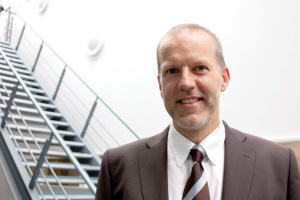Research carried out by scientists at Georgia Institute of Technology and The University of Manchester has revealed new insights into how cells stick to each other and to other bodily structures, an essential function in the formation of tissue structures and organs.
 Professor Martin Humphries
Professor Martin Humphries
It’s thought abnormalities in their ability to do play an important role in a broad range of disorders, including cardiovascular disease and cancer.
The study’s findings are outlined in the journal Molecular Cell and describe a surprising new aspect of cell adhesion involving the family of cell adhesion molecules known as integrins, which are found on the surfaces of most cells. The research uncovered a phenomenon termed “cyclic mechanical reinforcement,” in which the length of time during which bonds exist is extended with repeated pulling and release between the integrins and ligands that are part of the extracellular matrix to which the cells attach.
Professor Martin Humphries, the Dean of the Faculty of Life Sciences at Manchester led the UK research team and says the study suggests some new capabilities for cells: “This paper identifies a new kind of bond that is strengthened by cyclical applications of force, and which appears to be mediated by complex shape changes in integrin receptors.” He continues: “The findings also shed light on a possible mechanism used by cells to sense extracellular topography and to aggregate information through ‘remembering’ multiple interaction events.”
The cyclic mechanical reinforcement allows force to prolong the lifetimes of bonds, demonstrating a mechanical regulation of receptor-ligand interactions and identifying a molecular mechanism for strengthening cell adhesion through cyclical forces.
Cheng Zhu, a professor in the Coulter Department of Biomedical Engineering at Georgia Tech and Emory University led the U.S. research: “Many cell functions such as differentiation, growth and the expression of particular genes depend on cell interaction with the ligands of the intracellular matrix. The cells respond to their environment, which includes may mechanical aspects. This study has extended our understanding of how connections are made and how mechanical forces regulate interactions.”
Using delicate force measuring equipment, researchers in Professor Zhu’s lab and the laboratory of Professor Andres Garcia from the Woodruff School of Mechanical Engineering at Georgia Tech, collaborated to study adhesion between integrin and fibronectin, a protein component of the extracellular matrix. What they found was that cyclic forces applied to the bond switch it from a short lived state – with lifetimes of about one second – to a long-lived state that can exist for more than a hundred seconds.
Professors Zhu and Garcia alongside Georgia Tech graduate students Fang Kong, William Parks and David Dumbauld and postdoctoral fellow Zenhai Li used two different mechanical techniques to study the strength of bonds between integrin and fibronectin. One technique measured the bond strengths in purified molecules, while the other studied the effects of them in their native cellular environment.
Professor Zhu explains: “We have very precise force transducers that allow us to measure force on the scale of pico-newtons. We prepare the samples in such a way that we engage only one bond, we then control the application of force and observe what happens.”
The researchers first used an atomic force microscope to bring the integrin molecule together with the fibronectin, then separated the two. Instruments measured the pico-newton forces required to separate the molecules, and found that the duration of the bonds increased with the repetition of the contacts.
The second technique, known as BFP, involved the use of a fibronetctin-bearing glass bead attached to a red blood cell aspirated by a micropipette. Integrin expressed on a micropipette-aspirated cell was pressed into the bead, then pulled away over repeated cycles. Lifetime measurement confirmed that repeated pulling increased the longevity of the bonds.
Following this study the researchers hope to determine whether or not the cyclic mechanical reinforcement they observed is a universal property of many cellular adhesion molecules. They also hope to explore how cells use this cyclic mechanical reinforcement to gain a better understanding of the abnormal cellular adhesion mechanisms that occur in many diseases.
Professor Humphries says: “The findings of the paper have deep implications for our understanding of force-regulated signaling. There is abundant biological evidence for profound effects of extracellular tensility and elasticity in controlling processes such as cancer cell proliferation and stem cell differentiation, but the mechanisms whereby this information is transduced across the outer cell membrane are unclear.”